Insect outbreaks: Armyworms and sawflies
Editor’s note: This article is from the archives of the MSU Crop Advisory Team Alerts. Check the label of any pesticide referenced to ensure your use is included.
The most interesting insect news this week is happening in wheat fields across the state. Several MSU Extension field crop educators and crop consultants have reported large numbers of armyworms and leaf-feeding sawflies in wheat fields. They are feeding on the leaves and clipping off the wheat heads. Jim Bogart with the Orchard Hills Golf Course near Shelbyville reported that the outbreak of armyworms had spilled over to his golf course and drastic measures were needed to halt the marauding horde of caterpillars that were munching their way across the fairways. No human injuries were reported. The armyworms were not as fortunate, however.
True armyworm, Mythimna (=Pseudaletia) unipuncta (Lepiodoptera: Noctuidae) is a common insect pest of wheat, as well as corn, other crops and turf. True armyworms get their common name from their habit of gathering in large numbers, forming ranks and marching across the countryside eating every bit of grass (or crops related to grass) along the way. They can differ a great deal in color, depending on their size and what they are eating. Armyworm cannot over-winter in Michigan and moths must re-colonize the state from the south each season. Because of this, infestations vary from year-to-year and field-to-field. Moths are attracted to areas of dense grassy vegetation for egg laying. This includes ditch banks, weedy areas in crop fields, grass hay and wheat and other small grains.
Leaf-feeding sawflies, Pachynematus sp. (Hymenoptera: Tenthredinidae) are related to bees, wasps and ants. They are named for the female’s saw-like ovipositor, or egg laying device, used to insert eggs into plant material. Sawfly larvae resemble caterpillars, but they are easily distinguished by their numerous fleshy prolegs and single large eye on each side of their head. Moth and butterfly caterpillars have five or fewer pairs of prolegs, while sawfly larvae have seven to eight pairs. Many sawflies feed on trees and shrubs and are important landscape and forest pests, but some feed on grass and cereal crops.
In wheat, the sawflies are reported to feed on leaves and this year they are occurring in the same fields with true armyworm, sort of a double whammy. Sawflies have also been observed clipping off the wheat heads. Even in mixed populations of armyworm and sawfly, sawflies appear to be responsible for much of the clipping. The clipping occurs even when there is no leaf feeding, and during the day, when sawfly larvae are active. One observer reported that sawflies bit into the stem, causing the head to fall, then drank the liquid oozing from the cut. In many cases, tiller heads were clipped, which likely does not contribute to yield loss. But if heads of main stems are damaged, this is a concern because it directly reduces yield.
So far the summer of 2010 has been a banner year for caterpillars, first tent caterpillars up North and now, armyworms and the caterpillar-like leaf-feeding sawflies in wheat fields. What’s it gonna be next?
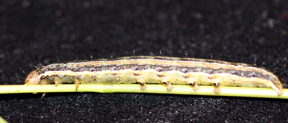
The true armyworm caterpillar.
Photo credit: Howard Russell, Diagnostic Services.
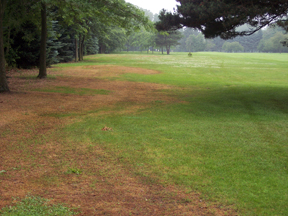
True armyworm feeding damage to golf
course turf. Photo credit: Jim Bogart, Orchard Hills Golf Course
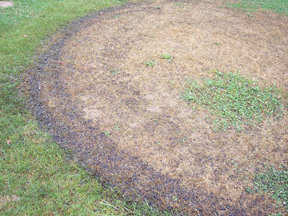
More armyworm damage to turf.
Photo credit: Jim Bogart, Orchard Hills Golf Course
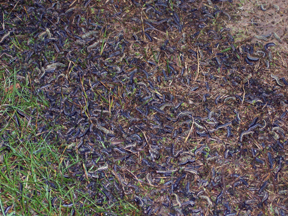
Dead armyworms: the price paid for feeding
on the grass of a well-equipped and determined
golf course.
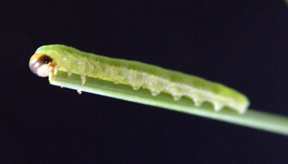
Leaf-feeding sawfly on clipped wheat stem.
Photo Credit: Gary Heilig, MSUE-Ingham County.
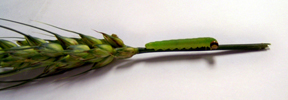
A proud leaf-feeding sawfly on his clipped
wheat head. Photo credit: Paul Gross, MSU/E-Isabella County
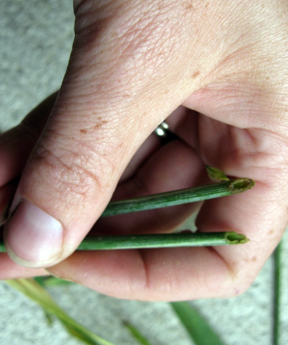
The outbreak of leaf-feeding sawflies extended
to our friends to the north. This photo shows clipped
wheat stems from an Ontario wheat field.
Photo credit: Tracey Baute, Ontario Ministry of Agriculture
Dr. DiFonzo's work is funded in part by MSU's AgBioResearch.



 Print
Print Email
Email
